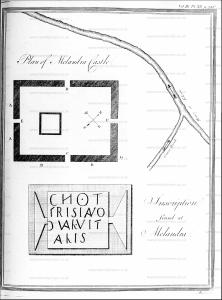Archaeologia Volume 3 Section XXVI
Archaeologia Volume 3 Section XXVI is in Archaeologia Volume 3.
An Account of an undescribed Roman Station [Melandra aka Ardotalia [Map]] in Derbyshire. By the Reverend Mr. Watson; in a Letter to the Reverend Mr. Norris, Secretary. Read at the Society of Antiquaries, Dec. 10, 1772.

On the south side of the river Mersey, (or as fome call it, the Edrow) near Wooley-bridge, in the township of Gamesley, and parish of Glossop, in Derbyfhire, is a Roma station, which no writer has mentioned, nor did any one know (as far as can be informed) that it had been constructed by that, people, till July 1771, when I made the discovery. The country people give it the name of Melandra Castle [Map] the area of it is called: the Castle-yard, and eleven fields adjoining to it are named in old; deeds the Castle Carrs.
It is situated, like many other Roman Rations, on moderately elevated ground, within the confluence of two rivers, as in the annexed plana, and was well supplied with good water. Very fortunately the plough has not defaced it, so that the form of it cannot be mistaken. The ramparts, which have confiderable quantities of hewn stones in them, seem to be about three yards broad. On the sides A and B were ditches, of which part remains, the rest is filled up; on the other sides there are such declivities, that there was no occasion for this kind of defence. On the north-east side, between the station and the water, great numbers of worked stones lie promiscuously, both above and under ground; there is also a subterraneous stream of water here, and a large bank of earth, which runs from the Station to the river. It seems very plain, that on this, and on the north-west sides, have been many buildings; and these are the only places where they could safely stand, because of the declivity between them and the two rivers.
Note a. Plate XII.

The extent of this Station is about 122 yards, by 112. The four gates, or openings into it, are exceedingly visible, as is also the foundation of a building within the area, about 25 yards square, which in all probability was the Praetorium.
The road from the Roman Station at Brough, in Derbyshire, entered Melandra at the gate C; the track of it, for a good part of the way, is still used, being set with large stones in the middle, and where it runs over mossy grounds, has proper drains cut on each side of it. It has the name of the Doctors Gate , and having passed through the middle of the station, was carried forward to a place in Yorkshire, called the Doctor's Lane-Head where it joined the great Roman way from Manchester to York.
From E, I am of opinion that a road went to Buxton, where I lately difcovered the site of a Roman station, unknown, I believe, at present, to any Antiquary but myself. Another road made of gravel, which the tenant has often ploughed up in his fields, seemed to point from hence towards Stockport, where the Romans had also a settlement, at the distance of a moderate march, on the banks of the same river. Whether any thing of this fort led from F into Yorkshire, I am not yet sufficiently informed; if there did, the raised bank already mentioned might be part of it, and it might either enter that county by the way of Woodhead, beyond which I have heard of an old disused road pointing over the mosses towards York; or it might take its direction under Bucton Castle towards Castleshaw, in Saddleworth.
At G, very near the east angle, the present tenant of the ground under the Duke of Norfolk, found several years ago, as he was searching for stones to build him an house, a stone, about sixteen inches long, and twelve broad, which is now walled up in the front of his house, and contains the annexed inscription, which I read thus; Cohortis prlmae Frisianorum Centurio Valerius Vitalis.
It was therefore a sister fort to that at Manchester, which was garrisoned by another part of the Frisian Cohort, as appears by an inscription found there, and published by Camden and others; as also by another inscription on a stone found near Manchefter, in my own possession, but not yet published.
There has been some doubt about the manner of writing the Latin word for Frisians. Horsley, page 90, s that, "perhaps both the inscription found at Manchester, and another at Bowes, in Richmondshire, should be read Frisiorum;" but this can hardly be; for that at Manchefter had Frisin: and I cannot but think, that there was originally a ligature also in the former part of the N, which was either effaced when it was found, or not properly attended to. The true meaning seems to be effectually established by this discovery at Melandra. If this was the same as the Cohors prima Frixagorum of the Notitia, stationed afterwards at Vindobala, or Rutchester on the Wall, the word probably was corrupted in those late times in which this work was composed. The date of this inscription I take to have been about the time of the Emperor Severus.
This is all I know at present about this remarkable discovery, which I doubt not will hereafter throw considerable light on the Roman history of this neighbourhood.
I am, Sir,
Your humble Servant,
John Watson.
Stockport, Dec. 5, 1772.